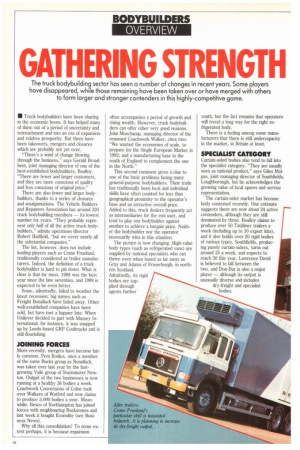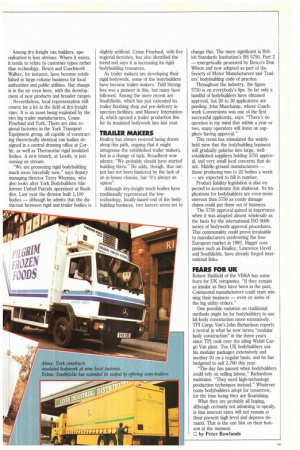GATHERING STRENGTH
Page 40

Page 41

If you've noticed an error in this article please click here to report it so we can fix it.
The truck bodybuilding sector has seen a number of changes in recent years. Some players have disappeared, while those remaining have been taken over or have merged with others to form larger and stronger contenders in this highly-competitive game.
• Truck bodybuilders have been sharing in the economic boom. It has helped many of them out of a period of uncertainty and retrenchment and into an era of expansion and relative prosperity. But there have been takeovers, mergers and closures which are probably not yet over.
"There's a wind of change blowing through the business," says Gerald Broadbent, joint managing director of one of the best-established bodybuilders, BoaHoy. "There are fewer and larger customers, and they are more conscious of quality and less conscious of original price."
There are also fewer and larger bodybuilders, thanks to a series of closures and amalgamations. The Vehicle Builders and Repairers Association has around 320 truck bodybuilding members — its lowest number for years. "They probably represent only half of all the active truck bodybuilders," admits operations director Robert Hadfield, "but we cover nearly all the substantial companies."
The list, however, does not include leading players such as Crane Fruehauf, traditionally considered as trailer manufacturers. Indeed, the definition of a truck bodybuilder is hard to pin down. What is clear is that for most, 1988 was the best year since the late seventies, and 1989 is expected to be even better.
Some, admittedly, failed to weather the latest recession; big names such as Freight Bona!lack have faded away. Other well-established companies have been sold, but have met a happier fate. When Unilever decided to part with Massey International, for instance, it was snapped up by Leeds-based GRP Cooltrucks and is still flourishing.
JOINING FORCES
More recently, mergers have become fairly common. Pem Bodies, once a member of the same Bucks group as Bonallack, was taken over last year by the fastgrowing Valle group of Sturniinster Newton. Output of the two businesses is now running at a healthy 36 bodies a week. Coachwork Conversions of Colne took over Walkers of Watford and now claims to produce 3,000 bodies a year. Meanwhile, Besco of Northampton has joined forces with neighbouring Buckstones and last week it bought Econolite (see Business News).
Why all this consolidation? To some extent perhaps, it is because expansion often accompanies a period of growth and rising wealth. However, truck bodybuilders can offer other very good reasons. John Muschamp, managing director of the renamed Coachwork Walker, cites two: "We wanted the economies of scale, to prepare for the Single European Market in 1992; and a manufacturing base in the south of England to complement the one in the North."
This second comment gives a clue to one of the basic problems facing many general-purpose bodybuilders. Their trade has traditionally been local and individual skills have often counted for less than geographical proximity to the operator's base and an attractive overall price. Added to this, truck dealers frequently act as intermediaries for the end user, and tend to play one bodybuilder against another to achieve a bargain price. Neither the bodybuilder nor the operator necessarily wins in this situation.
The picture is now changing. High-value body types (such as refrigerated vans) are supplied by national specialists who can thrive even when based as far away as Gray and Adams of Fraserburgh, in northern Scotland. Admittedly, its rigid bodies are supplied through agents further south, but the fact remains that operators will travel a long way for the right refrigerated body.
There is a feeling among some manufacturers that there is still undercapacity in the market, in Britain at least.
SPECIALIST CATEGORY
Curtain-sided bodies also tend to fall into the specialist category. "They are usually seen as national product," says Giles Malpas, joint managing director of Southfields, Loughborough, but he acknowledges the growing value of local spares and service representation.
The curtain-sider market has become hotly contested recently. One estimate suggests there are now about 24 active contenders, although they are still dominated by three. Boalloy claims to produce over 50 Taitliner trailers a week (including up to 10 export kits), and it also builds over 20 rigid bodies of various types. Southfields, producing purely curtain-siders, turns out around 25 a week, and expects to reach 30 this year. Lawrence David is believed to fall between the two, and Don-Bur is also a major player — although its output is unusually diverse and includes dry-freight and specialist bodies.
Among dry-freight van builders, specialisation is less obvious. Where it exists, it tends to relate to customer types rather than technology. Besco and Coachwork Walker, for instance, have become established in large-volume business for local authorities and public utilities. But change is in the air even here, with the development of new products and broader ranges.
Nevertheless, local representation still counts for a lot in the field of dry-freight vans. It is an asset being exploited by the two big trailer manufacturers, Crane Fruehauf and York. There are nine regional factories in the York Transport Equipment group, all capable of constructing theoretically identical van bodies designed in a central drawing office at Corby, as well as Thermostar rigid insulated bodies. A. new branch, at Leeds, is just coming on stream.
"We are promoting rigid bodybuilding much more forcefully now," says deputy managing director Terry Whyman, who also looks after York Bodybuilders (the fprmer United Parcels operation) at Rushden. Last year the division built 1,100 bodies — although he admits that the distinction between rigid and trailer bodies is
slightly artificial. Crane Fruehauf, with five regional factories, has also identified the trend and says it is increasing its rigid bodybuilding resources.
As trailer makers are developing their rigid bodywork, some of the bodybuilders have become trailer makers. Tidd Strongbox was a pioneer in this, but many have followed. Among the more recent are Southfields, which has just extended its trailer finishing shop and pre-delivery inspection facilities, and Massey International, which opened a trailer production line for its insulated bodywork late last year.
TRAILER MAKERS
Boalloy has always resisted being drawn along this path, arguing that it might antagonise the established trailer makers, but in a change of tack. Broadbent now admits: "We probably should have started building them." He adds, though, that output has not been hindered by the lack of an in-house chassis, but "it's always an option".
Although dry-freight truck bodies have traditionally represented the lowtechnology, locally-based end of the bodybuilding business, two factors seem set to change this. The more significant is British Standards Institution's BS 5750, Part 2 — energetically promoted by Besco's Don Wilson and now adopted as part of the Society of Motor Manufacturers and Traders' bodybuilding code of practice.
Throughout the industry, the figure 5750 is on everybody's lips. So far only a handful of bodybuilders have obtained approval, but 20 to 30 applications are pending. John Muschamp, whose Coachwork Conversions was one of the first successful applicants, says: "There's no question in my mind that within a year or two, many operators will insist on suppliers having approval."
This trend has stimulated the widelyheld view that the bodybuilding business will gradually polarise into large, wellestablished suppliers holding 5750 approval, and very small local concerns that do not. Middle-ground manufacturers — those producing two to 20 bodies a week — are expected to fall in number.
Product liability legislation is also expected to accelerate this shakeout. Its implications for bodybuilders are even more onerous than 5750 as costly damage claims could put them out of business.
The 5750 approval gained in importance when it was adopted almost wholesale as the basis for the international ISO 9000 series of bodywork approval procedures. This commonality could prove invaluable to manufacturers confronting the free European market in 1992. Bigger companies such as Boalloy, Lawrence David and Southfields, have already forged international links.
FEARS FOR UK
Robert Hadfield of the VBRA has some fears for UK companies. "If they remain as insular as they have been in the past, Continental manufacturers could start winning their business — even on some of the big utility orders."
One possible variation on traditional methods might be for bodybuilders to use kit-body construction more extensively. TPI Cargo Van's John Richardson reports a revival in what he now terms "modular body construction" in the three years since TPI took over the ailing Welsh Cargo Van plant. Ten UK bodybuilders use his modular packages extensively and another 30 on a regular basis, and he has budgeted to sell 2,700 this year.
"The day has passed when bodybuilders could rely on selling labour," Richardson maintains. "They need high-technology production techniques instead." Whatever route bodybuilders adopt for tomorrow, for the time being they are flourishing.
What they are probably all hoping, although certainly not admitting to openly, is that interest rates will not remain at their present high level and depress demand. That is the one blot on their horizon at the moment.
by Peter Rowlands




















































































































